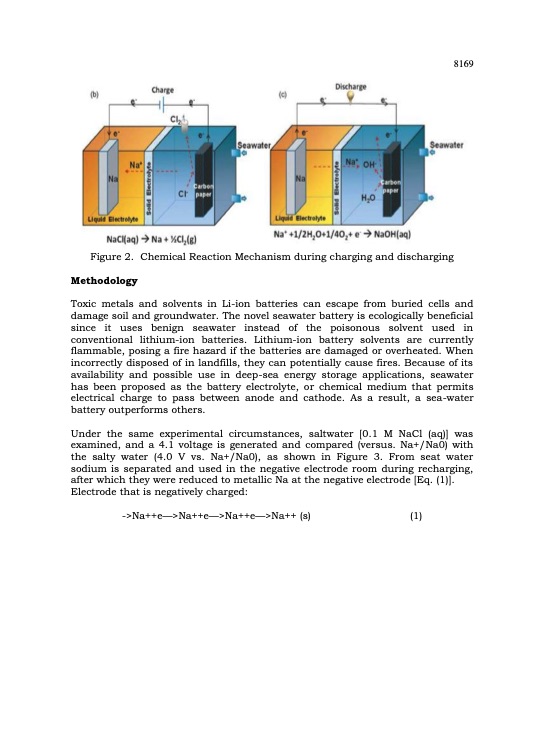
PDF Publication Title:
Text from PDF Page: 003
8169 Figure 2. Chemical Reaction Mechanism during charging and discharging Methodology Toxic metals and solvents in Li-ion batteries can escape from buried cells and damage soil and groundwater. The novel seawater battery is ecologically beneficial since it uses benign seawater instead of the poisonous solvent used in conventional lithium-ion batteries. Lithium-ion battery solvents are currently flammable, posing a fire hazard if the batteries are damaged or overheated. When incorrectly disposed of in landfills, they can potentially cause fires. Because of its availability and possible use in deep-sea energy storage applications, seawater has been proposed as the battery electrolyte, or chemical medium that permits electrical charge to pass between anode and cathode. As a result, a sea-water battery outperforms others. Under the same experimental circumstances, saltwater [0.1 M NaCl (aq)] was examined, and a 4.1 voltage is generated and compared (versus. Na+/Na0) with the salty water (4.0 V vs. Na+/Na0), as shown in Figure 3. From seat water sodium is separated and used in the negative electrode room during recharging, after which they were reduced to metallic Na at the negative electrode [Eq. (1)]. Electrode that is negatively charged: ->Na++e3>Na++e3>Na++e3>Na++ (s) (1)PDF Image | Electric lantern using sea water

PDF Search Title:
Electric lantern using sea waterOriginal File Name Searched:
electric-lantern-sea-water-battery.pdfDIY PDF Search: Google It | Yahoo | Bing
Product and Development Focus for Salgenx
Redox Flow Battery Technology: With the advent of the new USA tax credits for producing and selling batteries ($35/kW) we are focussing on a simple flow battery using shipping containers as the modular electrolyte storage units with tax credits up to $140,000 per system. Our main focus is on the salt battery. This battery can be used for both thermal and electrical storage applications. We call it the Cogeneration Battery or Cogen Battery. One project is converting salt (brine) based water conditioners to simultaneously produce power. In addition, there are many opportunities to extract Lithium from brine (salt lakes, groundwater, and producer water).Salt water or brine are huge sources for lithium. Most of the worlds lithium is acquired from a brine source. It's even in seawater in a low concentration. Brine is also a byproduct of huge powerplants, which can now use that as an electrolyte and a huge flow battery (which allows storage at the source).We welcome any business and equipment inquiries, as well as licensing our flow battery manufacturing.| CONTACT TEL: 608-238-6001 Email: greg@salgenx.com | RSS | AMP |